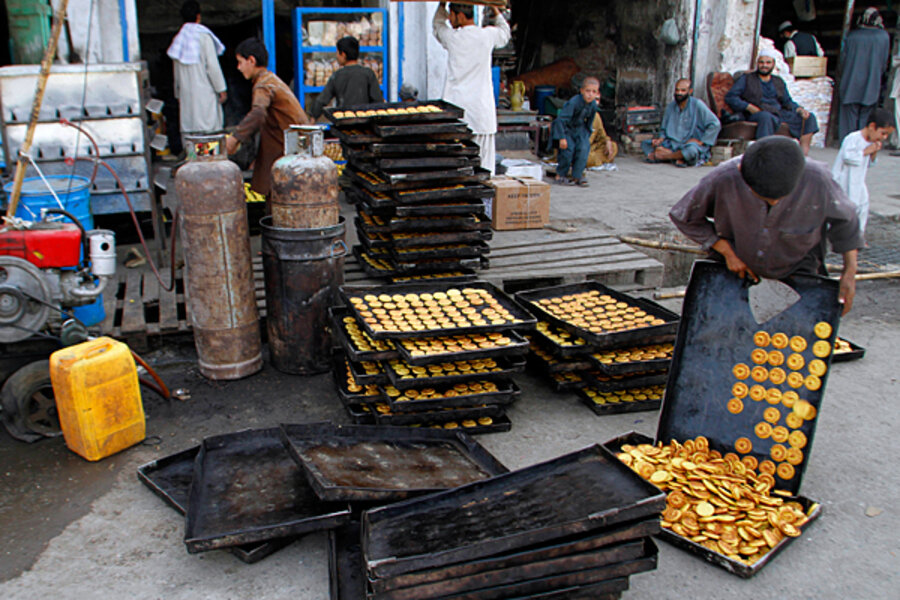Afghanistan's middle class: What will happen to us when the US leaves?
Loading...
| Kabul, Afghanistan
It’s an hour before sunset and 30-year-old Besmellah Khurram is feverishly texting his group of friends to find out which Kabul restaurant they should meet at to break their day-long fast.
“Ramadan is a great time for me because sometimes I break the fast with my family and sometimes with a large group of friends at one of Kabul’s busy restaurants,” says Mr. Khurram.
Khurram and his friends are enjoying some of the luxuries that have popped up in the past decade for the middle class in Afghanistan, such as disposable income to spend on eating out and purchasing the latest mobile phones, laptops, and even cars.
However, much of this newly established and mostly urban middle class is in danger of rapidly shrinking once again as more international aid projects and nongovernmental organizations shut down ahead of the 2014 transition, when most international security forces will leave Afghanistan and the country will be expected to govern itself without the direct help of the international community.
“Young working Afghans like me and my friends are who sustain the local businesses. If we lose our jobs, many of these local businesses will fail,” says Khurram, a graduate of Kabul University’s school of economics.
Khurram works as a manager for a private sector development project run by the German Society for International Cooperation, an aid organization. He says many of his friends also work for various international aid organizations or projects run by the US military and make anywhere from $2,000 to $4,000 a month, putting them in Kabul's upper middle class.
This is much higher than the average per capita income in Afghanistan, which according to the World Bank is $528. However uneven distribution of international aid and private investment have created large disparities between urban and rural income levels.
The high salaries, along with lucrative military and security contracts, have created a financial bubble in Afghanistan. Since 2001, this bubble has pushed up cost of living and contributed to the growth of the Afghan middle class, especially in urban areas.
Although official statistics or a formal definition of the middle class are not available, some economists estimate that the Afghan middle class may have grown from almost zero in 2001 to as much as 10 to 15 percent of Afghanistan’s estimated population of 27.5 million today. Based on that estimate, somewhere between 2.75 and 4.13 million Afghans now fall into the various levels of the middle class.
“There was an Afghan middle class in the 1970s and ‘80s, but during the ‘90s the increased fighting in the country forced most of the middle class families to leave the country or fall into poverty. After 2001 the middle class group has increased,” says Mohammad Ismail Rahimi, the general director of policy at the Afghan Ministry of Economy.
Some Afghans believe a strong middle class will be instrumental in promoting national unity and multiethnic political parties, two goals that are critical for long-term peace in the country.
“In Afghanistan the middle class are needed to hold the country’s leaders accountable and be a strong voice for the poor,” says 20-something Najla Hamid, a student at Kabul University.
However, it’s not clear whether many of the new middle class families will be able to fare the slow deflation of the financial bubble.
The most vulnerable are the families that have just made into the lower rungs of the middle class but haven’t made enough money to invest in property or small businesses to help them ride out any upcoming economic slumps.
“Less international aid to Afghanistan and not enough attention on private sector investment could quickly result in pushing middle class families to the brink of poverty again,” says Hamidullah Noor Ebad, an economics professor at Kabul University and a member of the Afghan government’s economic advisory council.
That is what happened to 30-something Khan Mohmad, who worked as an office assistant for one of the United Nations projects in Kabul from 2009 until January 2013. He says he was laid off from his position because the project he was working for ended.
“I was making $600 a month and was able to live comfortably off of that, but now I am back to driving a taxi so I can just meet the basic needs of my family. I am applying for other higher paying jobs but there are too many people looking for work now,” says Mr. Mohmad, who lives in Carte Naw, a district of Kabul where rent prices for a three-room house are about $200 a month.
Mohmad says he regrets not saving any money during the past 4 years or making a plan for his financial future.
“I could have put away a little bit of money every month, but 4 or 5 years ago I wasn’t in that mindset. I thought that these high paying jobs will always be here,” he says.
Fortunately Khurram did think ahead.
“A few years ago I saved up enough money to buy two homes in Kabul, one in Carte char for my family to live in and another property to rent out. I make a small profit on the rental property,” Khurram says.
He says the upcoming economic and political transition won’t be easy but he’s confident that he’ll get his family through it.





